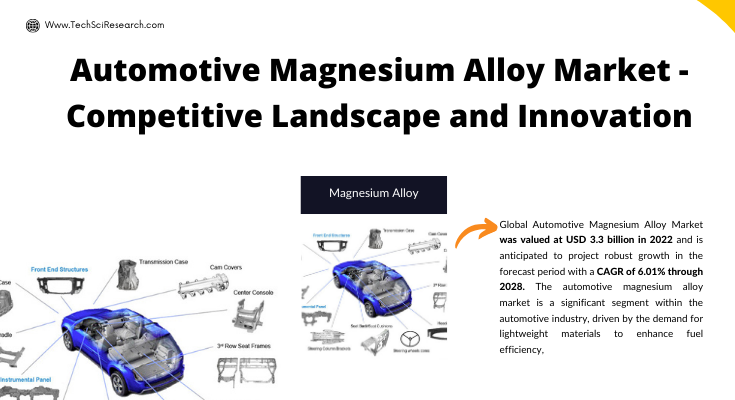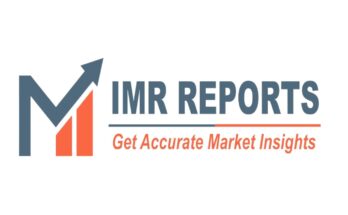According to TechSci Research report, “Global Automotive Magnesium Alloy Market – Industry Size, Share, Trends, Competition Forecast & Opportunities, 2028”, the Global Automotive Magnesium Alloy Market stood at USD 3.3 billion in 2022 and is anticipated to grow with a CAGR of 6.01% in the forecast period, 2024-2028.
The primary factors driving the market revenue growth are the growing demand for lightweight materials in the automotive industry, government regulations aimed at reducing emissions and fuel consumption, and consumer preference for fuel-efficient vehicles. Magnesium alloy demand in the automotive sector is being driven by the growing trend of lightweight vehicle production.
Because of their excellent strength-to-weight ratio, magnesium alloys are thought to be a good substitute for steel and aluminum in the automotive industry. Additionally, utilizing magnesium alloys in the production of automobiles can reduce fuel consumption, operating expenses, and environmental impact. Consequently, producers are using magnesium alloys more frequently in the interior and powertrain of vehicles.
Browse over market data Figures spread through XX Pages and an in-depth TOC on “Global Automotive Magnesium Alloy Market.” @ https://www.techsciresearch.com/report/automotive-magnesium-alloy-market/22718.html
The Global Automotive Magnesium Alloy market is an evolving and dynamic sector within the automotive industry, marked by the increasing utilization of magnesium alloys in various vehicle components. Magnesium alloys, known for their lightweight and high-strength properties, are playing a pivotal role in addressing industry-wide challenges and opportunities.
This market is shaped by several prominent drivers, trends, and challenges, each contributing to its growth and transformation. One of the primary drivers of the Global Automotive Magnesium Alloy market is the relentless pursuit of lightweighting. In an era where environmental sustainability and fuel efficiency are paramount, reducing vehicle weight has become a strategic imperative. Magnesium alloys, being significantly lighter than traditional materials like steel, aluminum, and cast iron, are prized for their ability to lower the overall weight of vehicles while maintaining structural integrity.
This reduction in weight directly contributes to improved fuel efficiency and reduced greenhouse gas emissions, aligning with stringent emissions regulations and fuel economy standards imposed by governments worldwide. As automakers strive to meet these standards and deliver eco-friendly transportation solutions, magnesium alloys have emerged as a compelling choice, propelling their demand in the automotive industry.
Furthermore, magnesium alloys are increasingly being recognized for their sustainability benefits, forming another driver in the Global Automotive Magnesium Alloy market. Magnesium, as a base element for these alloys, is abundant in nature, and its extraction processes are less energy-intensive compared to other metals. Moreover, magnesium alloys are highly recyclable, further minimizing their environmental impact. The recycling of magnesium alloys consumes less energy compared to primary production, contributing to resource conservation and reducing waste. This sustainability aspect resonates with automakers and consumers alike, fostering the adoption of magnesium alloys in vehicle manufacturing.
In addition to lightweighting and sustainability, magnesium alloys are driven by their capacity to enhance vehicle performance and safety. Magnesium alloys’ high strength-to-weight ratio supports improvements in acceleration, handling, and braking, thus elevating the driving experience. Furthermore, these alloys are increasingly incorporated into safety-critical components, such as crumple zones and side-impact structures, which are designed to absorb and dissipate impact forces during accidents, safeguarding vehicle occupants. The use of magnesium alloys in electric vehicles (EVs) is particularly advantageous, as their lightweight properties contribute to extended battery range and improved energy efficiency, addressing crucial challenges in EV adoption. The rise of EVs and the demand for high-performing, energy-efficient vehicles further underscore magnesium alloys’ role in the automotive sector.
Another pivotal driver is the development of advanced magnesium alloys and production processes. Research and innovation efforts have resulted in the creation of magnesium alloys with improved properties, including greater strength, corrosion resistance, and formability. These advancements have expanded the application of magnesium alloys in the automotive industry, making them suitable for various vehicle components, such as transmission cases, engine blocks, and seat frames. Moreover, innovations in manufacturing techniques, such as high-pressure die casting (HPDC) and heat treatment processes, have enabled the production of intricate and lightweight components that were once challenging to manufacture using magnesium alloys. As these alloys continue to evolve, they become increasingly attractive to automakers looking for materials that meet the evolving performance requirements of modern vehicles.
The growth of the electric vehicle (EV) market is another substantial driver in the Global Automotive Magnesium Alloy market. EVs rely on lightweight materials to maximize efficiency, battery range, and overall performance. Magnesium alloys play a pivotal role in reducing the weight of high-voltage components, such as batteries and electric motors, which is a critical consideration in EV design. Lower vehicle weight contributes to extended battery range, improved acceleration, and enhanced energy efficiency, all of which are fundamental to the success of electric mobility. As the EV market continues to expand, the demand for magnesium alloys is expected to grow, reinforcing their significance in the automotive industry.
Additionally, advancements in joining techniques and mixed-material structures are reshaping the Global Automotive Magnesium Alloy market. Automakers are increasingly using innovative methods to join magnesium alloys with other materials, such as steel and aluminum, to optimize vehicle weight while maintaining safety and performance standards. The differing thermal expansion rates between magnesium alloys and other materials have led to challenges in joining and structural integrity. Advanced techniques like friction stir welding and adhesive bonding have been employed to address these challenges, allowing for the seamless integration of magnesium alloys with other materials. The use of mixed-material structures enables automakers to leverage the strengths of each material while mitigating their respective weaknesses.
Major companies operating in the Global Automotive Magnesium Alloy Market are:
- Magontec Limited
- Meridian Lightweight Technologies Inc.
- Nanjing Yunhai Special Metals Co. Ltd.
- Smiths Advanced Metals Plc.
- STOLFIG Industrial Co. Ltd.
- Shanxi Yinguang Huasheng Magnesium Industry Co. Ltd.
- US Magnesium LLC
- Yunnan Aluminium Co. Ltd.
- Dead Sea Magnesium Ltd.
- DongGuan Eontec Co. Ltd.
Download Free Sample Report @ https://www.techsciresearch.com/sample-report.aspx?cid=22718
Customers can also request for 10% free customization on this report.
“The Global Automotive Magnesium Alloy market is a dynamic and evolving sector within the automotive industry, driven by a pursuit of lightweighting, sustainability, and performance enhancement. Magnesium alloys, known for their lightweight and high-strength properties, are a crucial element in addressing industry-wide challenges and opportunities. These alloys are increasingly favored for their role in improving fuel efficiency, meeting stringent emissions regulations, and enhancing the performance and safety of vehicles. Advanced alloys and production techniques continue to push the boundaries of what is achievable with magnesium, expanding its applications in various vehicle components. As the automotive industry undergoes a transformative shift, including the rise of electric vehicles and innovative joining methods, magnesium alloys are poised to play a central role in shaping the future of automotive manufacturing.” said Mr. Karan Chechi, Research Director with TechSci Research, a research-based management consulting firm.
“Automotive Magnesium Alloy Market – Global Industry Size, Share, Trends, Opportunity, and Forecast, Segmented By Alloy Type (AZ Magnesium Alloy, AM Magnesium Alloy, ZK Magnesium Alloy, and Others), By Application Type (Powertrain, Interior, Exterior, and Others), By Region, Competition, 2018-2028”, has evaluated the future growth potential of Global Automotive Magnesium Alloy Market and provides statistics & information on market size, structure and future market growth. The report intends to provide cutting-edge market intelligence and help decision makers take sound investment decisions. Besides, the report also identifies and analyzes the emerging trends along with essential drivers, challenges, and opportunities in the Global Automotive Magnesium Alloy Market.
You may also read:
Automotive Gear Oil Market Set for XX.XX% CAGR Through 2028- Forecasted Growth
Airbags and Seatbelts Market Detailed Analysis of Share, Growth [2028]
Automotive Coatings Market on the Rise [2028]- Driving Growth
Automotive Hypervisor Market Trends [2028]- Exploring the Dynamics of Industry
Automotive Bumper Market [2028] Analysis, Trends, and Key Players.
Table of Content-Automotive Magnesium Alloy Market
- Introduction
1.1. Product Overview
1.2. Key Highlights of the Report
1.3. Market Coverage
1.4. Market Segments Covered
1.5. Research Tenure Considered
- Research Methodology
2.1. Objective of the Study
2.2. Baseline Methodology
2.3. Key Industry Partners
2.4. Major Association and Secondary Sources
2.5. Forecasting Methodology
2.6. Data Triangulation & Validation
2.7. Assumptions and Limitations
- Executive Summary
3.1. Market Overview
3.2. Market Forecast
3.3. Key Regions
3.4. Key Segments
- Impact of COVID-19 on Global Automotive Magnesium Alloy Market
- Global Automotive Magnesium Alloy Market Outlook
5.1. Market Size & Forecast
5.1.1. By Value
5.2. Market Share & Forecast
5.2.1. By Alloy Type Market Share Analysis (AZ Magnesium Alloy, AM Magnesium Alloy, ZK Magnesium Alloy, and Others)
5.2.2. By Application Type Market Share Analysis (Powertrain, Interior, Exterior, and Others)
5.2.3. By Regional Market Share Analysis
5.2.3.1. Asia-Pacific Market Share Analysis
5.2.3.2. Europe & CIS Market Share Analysis
5.2.3.3. North America Market Share Analysis
5.2.3.4. South America Market Share Analysis
5.2.3.5. Middle East & Africa Market Share Analysis
5.2.4. By Company Market Share Analysis (Top 5 Companies, Others – By Value, 2022)
5.3. Global Automotive Magnesium Alloy Market Mapping & Opportunity Assessment
5.3.1. By Alloy Type Market Mapping & Opportunity Assessment
5.3.2. By Application Type Market Mapping & Opportunity Assessment
5.3.3. By Regional Market Mapping & Opportunity Assessment
- Asia-Pacific Automotive Magnesium Alloy Market Outlook
6.1. Market Size & Forecast
6.1.1. By Value
6.2. Market Share & Forecast
6.2.1. By Alloy Type Market Share Analysis
6.2.2. By Application Type Market Share Analysis
6.2.3. By Country Market Share Analysis
6.2.3.1. China Market Share Analysis
6.2.3.2. India Market Share Analysis
6.2.3.3. Japan Market Share Analysis
6.2.3.4. Indonesia Market Share Analysis
6.2.3.5. Thailand Market Share Analysis
6.2.3.6. South Korea Market Share Analysis
6.2.3.7. Australia Market Share Analysis
6.2.3.8. Rest of Asia-Pacific Market Share Analysis
6.3. Asia-Pacific: Country Analysis
6.3.1. China Automotive Magnesium Alloy Market Outlook
6.3.1.1. Market Size & Forecast
6.3.1.1.1. By Value
6.3.1.2. Market Share & Forecast
6.3.1.2.1. By Alloy Type Market Share Analysis
6.3.1.2.2. By Application Type Market Share Analysis


